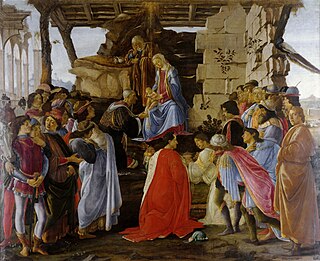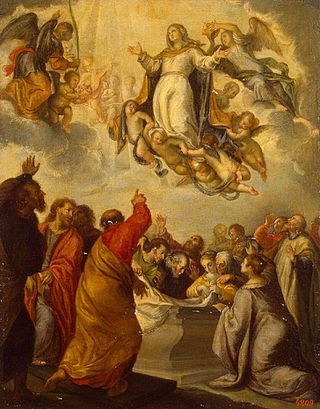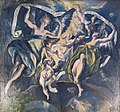
Doménikos Theotokópoulos, most widely known as El Greco, was a Greek painter, sculptor and architect of the Spanish Renaissance. El Greco was a nickname, and the artist normally signed his paintings with his full birth name in Greek letters often adding the word Κρής, which means "Cretan" in Ancient Greek.

Annibale Carracci was an Italian painter and instructor, active in Bologna and later in Rome. Along with his brother and cousin, Annibale was one of the progenitors, if not founders of a leading strand of the Baroque style, borrowing from styles from both north and south of their native city, and aspiring for a return to classical monumentality, but adding a more vital dynamism. Painters working under Annibale at the gallery of the Palazzo Farnese would be highly influential in Roman painting for decades.

An altarpiece is an work of art in painting, sculpture or relief representing a religious subject made for placing at the back of or behind the altar of a Christian church. Though most commonly used for a single work of art such as a painting or sculpture, or a set of them, the word can also be used of the whole ensemble behind an altar, otherwise known as a reredos, including what is often an elaborate frame for the central image or images. Altarpieces were one of the most important products of Christian art especially from the late Middle Ages to the era of Baroque painting.

The Museo del Prado, officially known as Museo Nacional del Prado, is the main Spanish national art museum, located in central Madrid. It houses collections of European art, dating from the 12th century to the early 20th century, based on the former Spanish royal collection, and the single best collection of Spanish art. Founded as a museum of paintings and sculpture in 1819, it also contains important collections of other types of works. The numerous works by Francisco Goya, the single most extensively represented artist, as well as by Hieronymus Bosch, El Greco, Peter Paul Rubens, Titian, and Diego Velázquez, are some of the highlights of the collection. Velázquez and his keen eye and sensibility were also responsible for bringing much of the museum's fine collection of Italian masters to Spain, now one of the largest outside of Italy.

The Adoration of the Shepherds is the traditional name for a New Testament episode in the story of Jesus's nativity, which is the subject of many works of art. In it shepherds are near witnesses to Jesus's birth in Bethlehem, arriving soon after he is actually born. The episode is recounted, or at least implied, in the Gospel of Luke and follows on from the annunciation to the shepherds, in which the shepherds are summoned by an angel to the scene of the birth. Like the episode preceding it, the adoration is a common subject in art, where it is often combined with the Adoration of the Magi. In such cases it is typically just referred to by the latter title.
The Baptism of Christ is an event described in the gospels of Matthew, Mark and Luke.
The Annunciation is the biblical episode of the announcement by the archangel Gabriel to Mary that she would become the mother of Jesus.

The Adoration of the Magi is a painting by the Italian Renaissance master Sandro Botticelli. Botticelli painted this piece for the altar in Gaspare di Zanobi del Lama's chapel in Santa Maria Novella around 1475. This painting depicts the Biblical story of the Three Magi following a star to find the newborn Jesus. The image of the altarpiece centers on the Virgin Mary and the newborn Jesus, with Saint Joseph behind them. Before them are the three kings who are described in the New Testament story of the Adoration of the Magi. The three kings worship the Christ Child and present him with gifts of gold, frankincense and myrrh. In addition, the Holy Family is surrounded by a group of people who came to see the child who was said to be the son of God.

Friar Juan Bautista Maíno, or Mayno was a Spanish Baroque painter.

The Coronation of the Virgin or Coronation of Mary is a subject in Christian art, especially popular in Italy in the 13th to 15th centuries, but continuing in popularity until the 18th century and beyond. Christ, sometimes accompanied by God the Father and the Holy Spirit in the form of a dove, places a crown on the head of Mary as Queen of Heaven. In early versions the setting is a Heaven imagined as an earthly court, staffed by saints and angels; in later versions Heaven is more often seen as in the sky, with the figures seated on clouds. The subject is also notable as one where the whole Christian Trinity is often shown together, sometimes in unusual ways. Crowned Virgins are also seen in Eastern Orthodox Christian icons, specifically in the Russian Orthodox church after the 18th century. Mary is sometimes shown, in both Eastern and Western Christian art, being crowned by one or two angels, but this is considered a different subject.

Francisco Camilo was a Spanish painter, the son of an Italian immigrant who had settled in Madrid. When his father died, his mother remarried, and Camilo became the stepson of the painter Pedro de las Cuevas.

The Nativity of Jesus has been a major subject of Christian art since the 4th century.
Francisco de Mora (c.1553–1610) was a Spanish Renaissance architect.

The Adoration of the Kings is a large oil-on-oak painting by Jan Gossaert, dated to 1510–15, depicting the Adoration of the Magi. Although Gossaert's name is signed on the border of Balthazar's richly embroidered headdress, and on a collar worn by Balthazar's turbaned attendant, the painting was occasionally attributed to Albrecht Dürer in the 17th and 18th centuries. In 2010, Ainsworth suggested that the work was a collaboration between Gossaert and Gerard David.
The Doña María de Aragón Altarpiece was an altarpiece painted between 1596 and 1599 by El Greco for the chapel of the Colegio de la Encarnación in Madrid. The college was secularised during Goya's lifetime and the altarpiece was dismantled. There has been much speculation over which paintings belonged to the work. The consensus view is that it consisted of six large canvases and a seventh, now lost. Five of those six canvases are now in the Prado and the sixth is in the National Museum of Art of Romania in Bucharest.

Annunciation is an oil painting on canvas executed ca. 1603–1605 by El Greco, produced as part of a contract to provide paintings for a church in Illescas, Toledo. The painting still hangs in the church, the Santuario de Nuestra Señora de la Caridad, with three others from the same set, whilst the fifth is now in the National Museum of Art of Romania.

Nativity is a 1603-1605 painting of the Nativity of Jesus by El Greco. It was one of five paintings painted for the high altarpiece of the Santuario de Nuestra Señora de la Caridad in Illescas, Toledo. It and three others still hang there, whilst the fifth is in the National Museum of Art of Romania.

Annunciation is a 1609 work by El Greco, now in a private collection in Madrid. It is a variant on his work on the same theme as part of the Doña María de Aragón Altarpiece. The painter died in April 1614 and the work may have been completed by his son Jorge Manuel after that date. It is not an independent composition but a cut-down fragment of the whole, designed for and installed in the chapel of the Hospital de Tavera.

Adoration of the Magi is a painting in tempera on wood panel by Luca Signorelli (1450–1523) and his assistants, executed c. 1493–1494, and now in the Louvre in Paris. It was probably the first painting he produced in Città di Castello, and originally hung over the main altar of the monastery church of Sant'Agostino. The surface displayed within the frame is 331 cm by 245.5 cm. In late 2022 it was not on display.





















